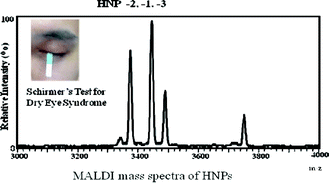Characterization of human neutrophilpeptides (α-Defensins) in the tears of dry eye patients
Abstract
The potential

* Corresponding authors
a
Department of Chemistry, National Sun Yat-Sen University, Kaohsiung, Taiwan
E-mail:
jetea@mail.nsysu.edu.tw
Fax: +886-7-5253933
Tel: +886-7-5253933
b
Department of Ophthalmology, Chang Gung Memorial Hospital, Kaohsiung Medical Center, Chang Gung University College of Medicine, Kaohsiung, Taiwan
E-mail:
wooopc@gmail.com
Fax: +886-7-7317123-2801
Tel: +886-7-7317123-2801
c National Sun Yat-Sen University–Kaohsiung Medical University Joint Research Center, Taiwan
d Cancer Center, Kaohsiung Medical University Hospital, Taiwan
The potential

 Please wait while we load your content...
Something went wrong. Try again?
Please wait while we load your content...
Something went wrong. Try again?
L. Lo, P. Wu, Y. Wu and J. Shiea, Anal. Methods, 2010, 2, 1934 DOI: 10.1039/C0AY00243G
To request permission to reproduce material from this article, please go to the Copyright Clearance Center request page.
If you are an author contributing to an RSC publication, you do not need to request permission provided correct acknowledgement is given.
If you are the author of this article, you do not need to request permission to reproduce figures and diagrams provided correct acknowledgement is given. If you want to reproduce the whole article in a third-party publication (excluding your thesis/dissertation for which permission is not required) please go to the Copyright Clearance Center request page.
Read more about how to correctly acknowledge RSC content.
 Fetching data from CrossRef.
Fetching data from CrossRef.
This may take some time to load.
Loading related content
